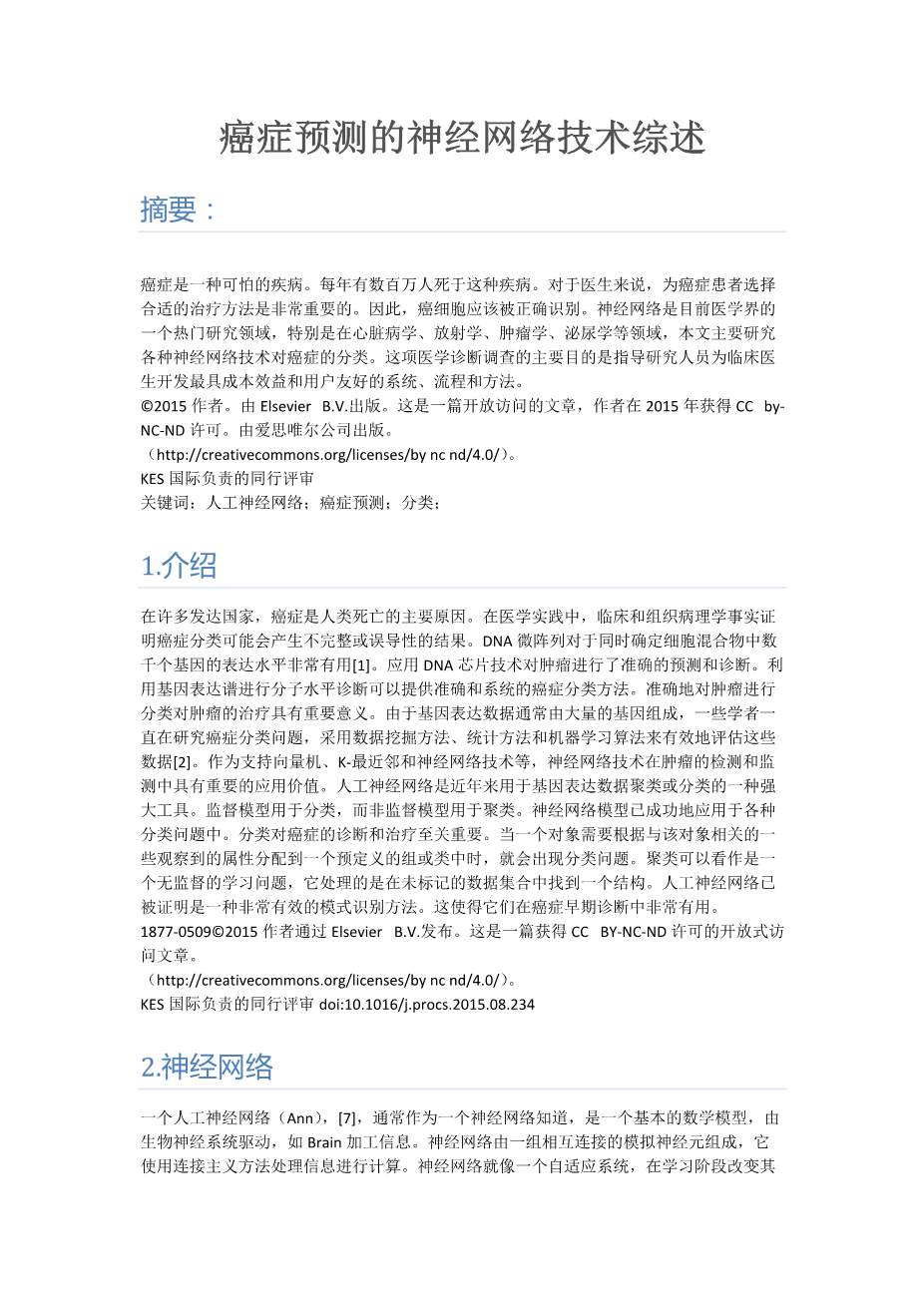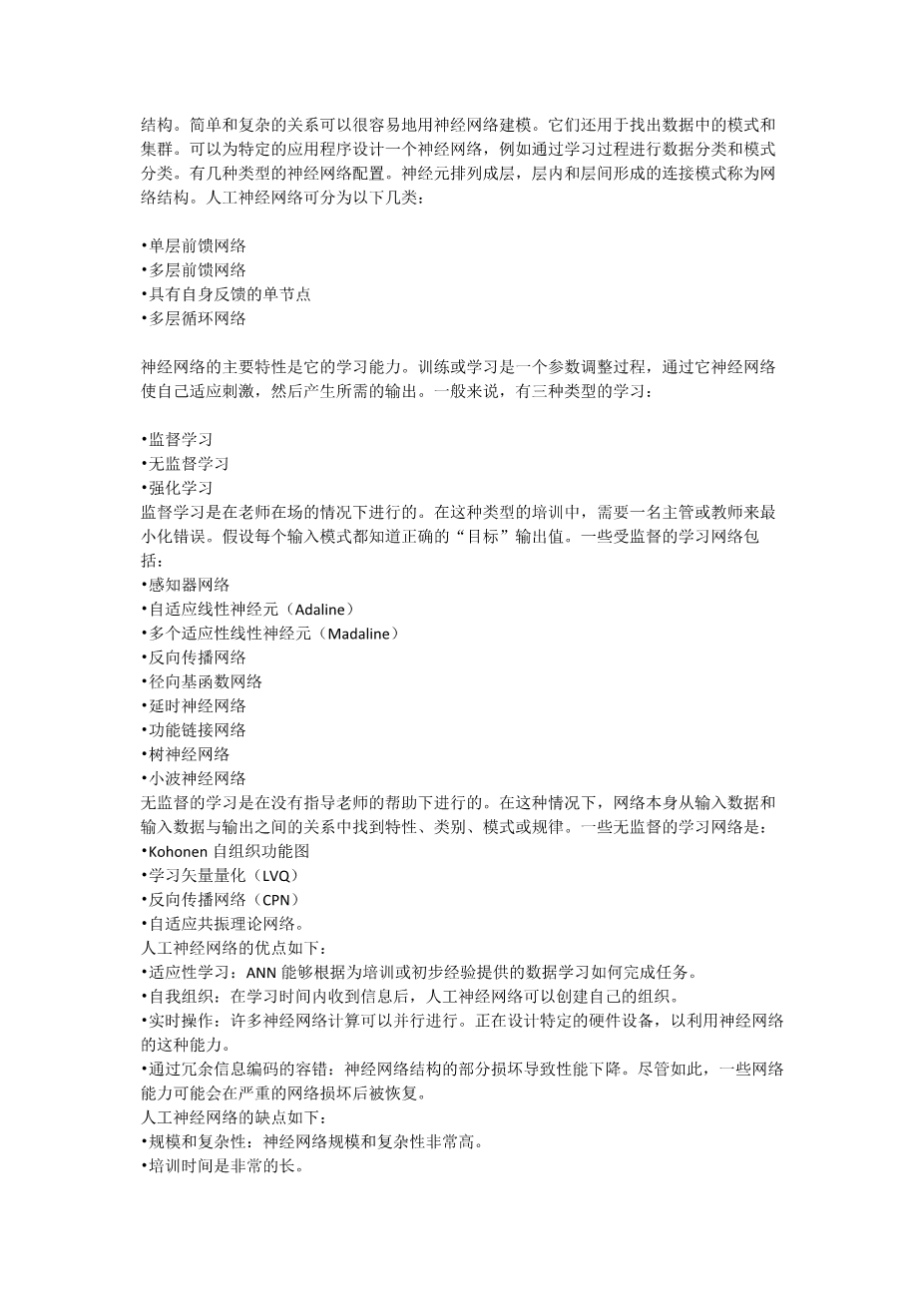Available online at www.sciencedirect.com
ScienceDirect
Procedia Computer Science 60 (2015) 769 – 774
19th International Conference on Knowledge Based and Intelligent Information and Engineering Systems
Neural Network Techniques for Cancer Prediction: A Survey
Shikha Agrawal, Jitendra Agrawal
Department of Computer Science and Engineering, Rajiv Gandhi Proudyogiki Vishwavidyalaya, Bhopal, India
Abstract
Cancer is a dreadful disease. Millions of people died every year because of this disease. It is very essential for medical practitioners to opt a proper treatment for cancer patients. Therefore cancer cells should be identified correctly. Neural networks are currently a burning research area in medical science, especially in the areas of cardiology, radiology, oncology, urology and etc. In this paper, we are surveying various neural network technologies for classification of cancer. The main aim of this survey in medical diagnostics is to guide researchers to develop most cost effective and user friendly systems, processes and approaches for clinicians.
© 2015 The Authors. Published by Elsevier B.V. This is an open access article under the CC BY-NC-ND license © 2015 The Authors. Published by Elsevier B.V.
(http://creativecommons.org/licenses/by-nc-nd/4.0/).
Peer-review under responsibility of KES International
Keywords: Artificial Neural Network; Cancer Prediction; Classification;
1. Introduction
Cancer is a major root cause of disease among human deaths in many developed countries. Cancer classification in medical practice trusted on clinical and histopathological facts may produce incomplete or misleading results .The DNA microarray is very useful to determine the expression level of thousands of genes simultaneously in a cell mixture [1]. DNA microarray technology has been applied to find out the accurate prediction and diagnosis of cancer. Molecular level diagnostics with gene expression profiles can offer the methodology of accurate and systematic cancer classification. It’s very important for treatment of cancer to classify tumor accurately. Since the gene expression data generally comprise of huge number of genes, several scholars have been scrutinizing the problems of cancer classification using data mining approaches, statistical methods and machine learning algorithms to effectually evaluate these data [2].Various machine learning techniques are used for cancer classification, such as support vector machine, k-nearest neighbor and neural network techniques etc. Neural network techniques are very useful for detection and monitoring of cancer. Artificial neural network is a robust tool recently used as either clustering or classification of gene expression data. Supervised models are used for classification while unsupervised models are used for clustering. Neural network model has been successfully implemented in various classification problems. Classification is crucially important for cancer diagnosis and treatment. A classification problem occurs when an object needs to be allotted into a predefined group or class based on a number of observed attributes related to that object. Clustering can be considered as unsupervised learning problem, it deals with finding a structure in collection of unlabeled data. Artificial neural network had been proven a very effective method for pattern recognition. This made them very useful for diagnosis of cancer disease at very early stages.
1877-0509 © 2015 The Authors. Published by Elsevier B.V. This is an open access article under the CC BY-NC-ND license
(http://creativecommons.org/licenses/by-nc-nd/4.0/).
Peer-review under responsibility of KES International
doi:10.1016/j.procs.2015.08.234
770 Shikha Agrawal and Jitendra Agrawal / Procedia Computer Science 60 (2015) 769 – 774
2. Neural Network
An Artificial Neural Network (ANN)[7] , usually known as a neural network, is basically a mathematical model motivated by biological nervous systems like brain processes information. A neural network comprises an interconnected group of simulated neurons and it uses connectionist approach to process information for computation. Neural network works like an adaptive system, which changes its structure in learning phase. Simple and complex relationships can be easily modeled using neural networks. They are also used to find out patterns and clusters in data. An ANN can be designed for a particular application, such as data classification and pattern categorization through a learning process. There are several types of neural network configurations. The arrangement of neurons to form layers and the connection pattern formed within and between layers is called the network structures. An ANN can be classified into following categories:
- Single layer feed-forward network
- Multilayer feed- forward network
- Single node with its own feedback
- Multilayer recurrent network
The main property of an ANN[2] is its ability of learning. Training or learning is a procedure of parameter tuning by which a neural network adapts itself to a stimulus and then desired output is produced. Broadly, there are three types of learning:
- Supervised learning
- Unsupervised learning
- Reinforcement learning
Supervised learning is performed in the presence of a teacher. In this type of training, a supervisor or teacher is required for error minimization. It is assumed that the correct “target” output values are known for each input pattern. Some supervised learning networks are:
- Perceptron networks
- Adaptive linear neuron (Adaline)
- Multiple Adaptive linear neurons(Madaline)
- Back-Propaga
剩余内容已隐藏,支付完成后下载完整资料


英语译文共 7 页,剩余内容已隐藏,支付完成后下载完整资料
资料编号:[426753],资料为PDF文档或Word文档,PDF文档可免费转换为Word
原文和译文剩余内容已隐藏,您需要先支付 30元 才能查看原文和译文全部内容!立即支付


